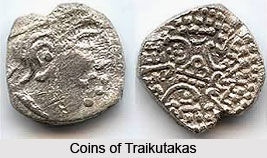 Medieval History of Raigad District begins from the glorious rule of Chalukyas of Badami. At that time, Raigad District reached at its top in art and architecture. Later the
Traikutakas, Shilaharas, Yadavas and Marathas ruled this place with pomp and glory.
Medieval History of Raigad District begins from the glorious rule of Chalukyas of Badami. At that time, Raigad District reached at its top in art and architecture. Later the
Traikutakas, Shilaharas, Yadavas and Marathas ruled this place with pomp and glory.
Rule of Traikutakas
Traikutakas kings derived their family name from the Trikuta hill in Aparanta that is Northern Konkan. One of the Traikutaka kings is actually described as ruling over Aparanta. Coins of these kings have been found in Southern Gujarat, Konkan as well as Maratha countries on the other side of Ghats. These kings ruled the place from 248-249 AD, which probably speaks of their relation with Abhiras. The Candravalli inscription refers to the separate conflict of Abhiras as well as Traikutakas with the Kadamba king Mayurasarman who ruled about the middle of the 4th century. Kalidasa`s Raghuvamsa written in 4th or 5th century contains a veiled reference to the Traikutaka kingdom of Aparanta. After that Kalachuris came into power and later they were subdued by the Chalukyas of Badami of the 6th century. Thus the Chalukya king Mangalesa (597-98 to 610-11) claims to have put to flight Buddharaja, the son of Kalachuri Sankaragana.
Rule of Shilaharas
History of Raigad district in 7th century is still wrapped up in obscurity. Silaharas of Thana rose to eminence at about 800 AD and ruled for a period of four centuries. Silaharas were feudatories in status. They owed their allegiance first to the Rastrakutas, then to Calukyas as well as Kadambas and finally to the Yadavas of Devgiri. Rulers of Shilaharas claim to have descended from Jimutavahana.
Rule of Shilaharas of South Konkan
Rattaraja was the last ruler of Shilaharas, where the region rose into prominence. The document is extremely important as it not only gives the genealogy of the ten ancestors of Rattaraja, but mentions their specific exploits also. Sanaphulla (765 to 795) Dhammayira (795 to 820) Aiyaparaja (820 to 845) Avasara I (845 to 870) Adityavarman (870 to 895) Avasara II (895 to 920) Indraraja (920 to 945) Bhima (945 to 970) Avasara III (970 to 995) Rattaraja (995 to 1020) ruled this place.
Rule of Yadavas of Devgiri
Yadavas of Devgiri ruled over the Deccan including Konkan as well as Kolaba (Raigad) from the days of Sihghana (1200 to 1247) down to Ramacandra or Ramadeva (1271-1310) and his son Sankara (1311-1313). Ramacandra as well known was taken prisoner by Malik Kafur, the General of Ala-ud-din, in the battle at Devagiri in 1307 AD.
Rule of Muslims
In the year 1313 A. D, Malik Kafur sent again to the Deccan for subduing Tailahgana put Ramacandra`s son Sahkara also to death and fixed his residence at Devagiri. The revolt of Harapala, the son-in-law of Ramcandra was suppressed finally by Mubarak, the third son of Ala-ud-din Khilji in 1317, who seized and inhumanly burnt him alive. From this time the Delhi sultanate have held ports in Kolaba. Ceul was one of such ports. It must be said in fairness to Vijayanagar or Anegundi kings that they maintained control over many parts of Kolaba up to 1377. In fact before Muslim domination, the south Konkan including present Raigad district was under the control of a Lingayat dynasty called the Kanara gings, whose headquarters were at Anegundi. By the end of the 14th century, however, the whole of Konkan including Kolaba came under the rule of the Delhi Sultanate.
Rule of Marathas
After the down fall of Musghal rule in India, Marathas came into the power with the hand of Shivaji. He thereby built the forts in Raigad. After the rule of Marathas, British East India Company came into the limelight of the power and turned this district into atourist importance.



















